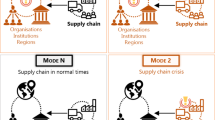Abstract
This paper studies the important problem of how to coordinate the capacity procurement model with asymmetric demand information. Under the model, the supplier has to secure necessary capacity before receiving a firm order from the manufacturer who possesses private demand information for her product. Optimal supply chain performance requires the manufacturer to share her forecast truthfully and the supplier to build enough capacity. In the literature, some elaborate contracts are designed to solve the problem. However, the authors prove that two simple conventional contracts (linear capacity reservation contract and payback agreement) can coordinate the supply chain and guarantee credible information sharing. Besides, the authors propose a new mechanism in which punishment is imposed in the payment function to bind the parties. To avoid punishment, the firms will choose the best decision for the entire supply chain. The contracts in this paper are all simple and easy to implement. The authors believe this work provides some insights to design coordination contracts in theory or in practice.
Similar content being viewed by others
References
Taylor T A and Plambeck E L, Simple relational contracts to motivate capacity investment: Price only vs. price and quantity, Manufacturing & Service Operations Management, 2007, 9(1): 94–113.
Özer Ö and Wei W, Strategic commitments for an optimal capacity decision under asymmetric forecast information, Management Science, 2006, 52(8): 1238–1257.
Cachon G P and Lariviere M A, Contracting to assure supply: How to share demand forecasts in a supply chain, Management Science, 2001, 47(5): 629–646.
Egri P and Vncza J, Channel coordination with the newsvendor model using asymmetric information, International Journal of Production Economics, 2012, 135(1): 491–499.
Lobel I and Xiao W, Technical note-optimal long-term supply contracts with asymmetric demand information, Operations Research, 2017, 65(5): 1275–1284.
Ha A Y, Supplier-buyer contracting: Asymmetric cost information and cutoff level policy for buyer participation, Naval Research Logistics, 2001, 48(1): 41–64.
Corbett C J and de Groote X, A supplier’s optimal quantity discount policy under asymmetric information, Management Science, 2000, 46(3): 444–450.
Burnetas A, Gilbert S M, and Smith C E, Quantity discounts in single-period supply contracts with asymmetric demand information, IIE Transactions, 2007, 39(5): 465–479.
Babich V, Li H, Ritchken P, et al., Contracting with asymmetric demand information in supply chains, European Journal of Operational Research, 2012, 217(2): 333–341.
Liu H, Jiang W, Feng G, et al., Information leakage and supply chain contracts, Omega, 2020, 90, 101944.
Fang Y, Wang X, and Yan J, Green product pricing and order strategies in a supply chain under demand forecasting, Sustainability, 2020, 12(2): 713–736.
Cai W and Singham D I, A principal agent problem with heterogeneous demand distributions for a carbon capture and storage system, European Journal of Operational Research, 2018, 264(1): 239–256.
Amornpetchkul T, Duenyas I, and Sahin O, Mechanisms to induce buyer forecasting: Do suppliers always benefit from better forecasting? Prod. Oper. Manag., 2015, 24(11): 1724–1749.
Oh S and Özer Ö, Mechanism design for capacity planning under dynamic evolutions of asymmetric demand forecasts, Management Science, 2013, 59(4): 987–1007.
Tal A and Noam S, The effect of information asymmetry on ordering and capacity decisions in supply chains, European Journal of Operational Research, 2021, 292(2): 562–578.
Chen F, Information sharing and supply chain coordination, Supply Chain Management: Design, Coordination and Operation, Vol. 11 of Handbooks in Operations Research and Management Science, Elsevier, 2003, 341–421.
Feng Q, Lai G, and Lu L X, Dynamic bargaining in a supply chain with asymmetric demand information, Management Science, 2015, 61(2): 301–315.
Muzaffar A, Deng S, and Malik M N, Contracting mechanism with imperfect information in a two-level supply chain, Oper. Res. Int. J., 2020, 20: 349–368.
Li L and Liu K, Coordination contract design for the newsvendor model, European Journal of Operational Research, 2020, 283(1): 380–389.
Taylor T A and Xiao W, Does a manufacturer benefit from selling to a better-forecasting retailer? Management Science, 2010, 56(9): 1584–1598.
Wang J, Liu Z, and Zhao R, On the interaction between asymmetric demand signal and forecast accuracy information, European Journal of Operational Research, 2019, 277(3): 857–874.
Taylor T A and Plambeck E L, Supply chain relationships and contracts: The impact of repeated interaction on capacity investment and procurement, Management Science, 2007, 53(10): 1577–1593.
Ren Z J, Cohen M A, Ho T H, et al., Information sharing in a long-term supply chain relationship: The role of customer review strategy, Operations Research, 2010, 58(1): 81–93.
Gibbons R, Game Theory for Applied Economists, Princeton University Press, Princeton, NJ, 1992.
Crawford V P and Sobel J, Strategic information transmission, Econometrica, 1982, 50(6): 1431–1451.
Cachon G P and Lariviere M A, Supply chain coordination with revenue-sharing contracts: Strengths and limitations, Management Science, 2005, 51(1): 30–44.
Author information
Authors and Affiliations
Corresponding author
Additional information
This paper was supported by the National Natural Science Foundation of China under Grant No. 72071198.
This paper was recommended for publication by Editor YU Yugang.
Rights and permissions
About this article
Cite this article
Li, L., Liu, K. Simple Contracts to Coordinate the Capacity Procurement Model with Asymmetric Demand Information. J Syst Sci Complex 35, 245–263 (2022). https://doi.org/10.1007/s11424-021-0031-6
Received:
Revised:
Published:
Issue Date:
DOI: https://doi.org/10.1007/s11424-021-0031-6




